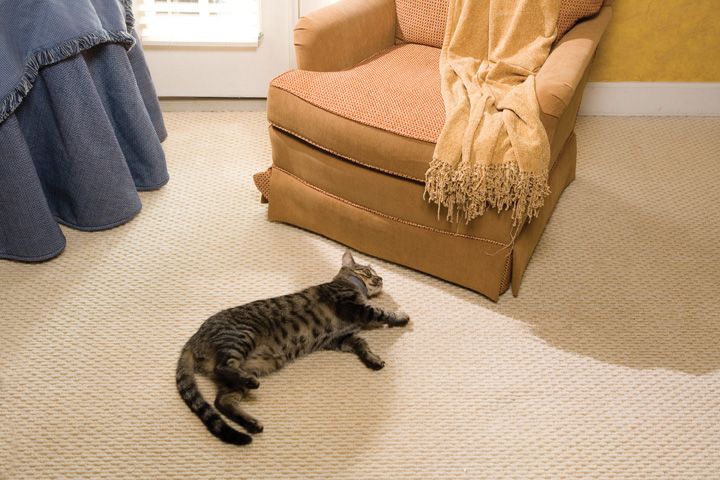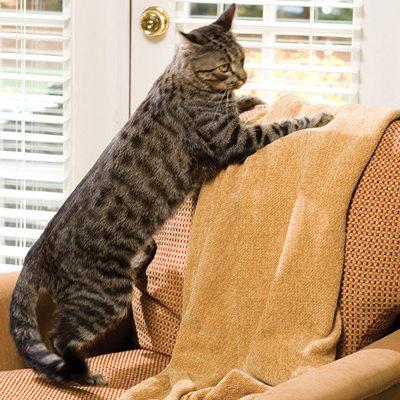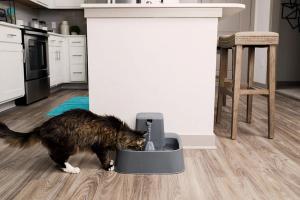Your cat strolls into the room, rubs against your legs, and reaches her front paws up as if to stretch against the corner of your living room couch--then sinks her claws into the fabric and begins scratching with determination and exuberance. You shout at her, shooing her away then grabbing her and placing her on the brand new scratching post sitting nearby. Instead of scratching there, she races out of the room and hides under your bed. You sigh in exasperation. Why won't your cat scratch the post instead of your expensive couch?
Why Cats Scratch
While you may wish that your cat would quit scratching altogether, the behavior is instinctual. Your cat scratches her favorite surfaces for several reasons.
-
 Scratching helps a cat stretch her muscles and stay limber.
Scratching helps a cat stretch her muscles and stay limber. - The action aids in shedding the outer layers of a cat's claws to keep them clean and smooth.
- Clawing helps a cat mark her territory. The claw marks are a very visible sign of possession. In addition, when a cat scratches a surface, she releases her scent through her paw pads as another means of marking her territory.
- The almost mindless, repetitive nature of scratching helps a cat reduce stress.
- As a bonus, scratching just plain feels good to a cat.
So why does your cat choose your couch as her territory? It's because you hang out there, too. A cat scratches near where her family spends a lot of time to mark that territory as her own, mostly because she enjoys being there with you and wants to share her scent with you.
The first step in encouraging your cat to find another place to scratch besides your furniture, then, is to place a suitable item right next to the unsuitable item the cat currently prefers. Before you run right out and buy a scratching post, however, take a bit of time to figure out your cat's particular scratching behavior.
Scratching Preferences
 Not every cat scratches the same way. Some prefer vertical surfaces while others like horizontal ones. Some will even lie on their backs and scratch the surface above them. Ever wonder why the undersides of some people's couches or box springs are shredded? Now you know.
Not every cat scratches the same way. Some prefer vertical surfaces while others like horizontal ones. Some will even lie on their backs and scratch the surface above them. Ever wonder why the undersides of some people's couches or box springs are shredded? Now you know.
Similarly, not all cats like to scratch the same type of surface. Some like carpet, others like cardboard or the fabric that typically covers a couch. Some even prefer wood.
The next time your cat scratches something in your house, watch her. Is she concentrating her efforts on the horizontal arm of your easy chair? She most likely prefers scratching in a horizontal orientation. Is she scratching the legs of your fancy dining room table? Her favorite surface may be wood.
With these preferences in mind, you can select a scratching post or cat tree that will entice her to scratch appropriately. A range of products are available to meet your cat's needs, from corrugated cardboard infused with dried catnip to multi-level cat trees covered with sisal rope and carpet. You can even build your own if you can't find just the right item.
Redirecting Scratching
With a new scratching post in your possession, it's time to start retraining your cat. You want your cat to associate the new item with an area she has already established as her territory. It is likely that the scratching post doesn't quite go with your decor,but neither does a shredded couch.
-
 Place the post or other scratching item near the off-limits surfaces, as close to them as possible.
Place the post or other scratching item near the off-limits surfaces, as close to them as possible. - Lure her to the post with one of her favorite feather toys.
- Praise your cat every time she scratches the post.
- Give her a treat when she scratches it so she begins to associate the post with positive experiences.
- Rub dried catnip on the post surfaces.
- If you own more than one cat, provide a post or scratching item for each cat in your home plus one more.
- Be sure the posts are in high-traffic areas that the cat will visit many times per day.
 While you work on making the scratching post more desirable to your cat, consider these methods to make your couch less appealing.
While you work on making the scratching post more desirable to your cat, consider these methods to make your couch less appealing.
- Repellent Sprays. Pet stores sell sprays specifically formulated with harmless scents that repel your cat from off-limits areas.
- Foil. Some cat owners temporarily affix foil to the surfaces of their furniture that they wish their cats would avoid. Many cats do not like the feel of foil against their paws and claws.
- Squirt bottles. When you see your cat scratching an off-limits surface, resist the urge to yell. Instead, squirt her with water so she will associate that surface with an unpleasant (yet still harmless) squirt of water.
To further protect your furniture, be sure to clip your cat's claws regularly. Doing so keeps them in good condition, lessening the need for the cat to scratch to condition the claws. Keeping the nails shorter prevents them from doing as much damage when she does scratch your couch.








